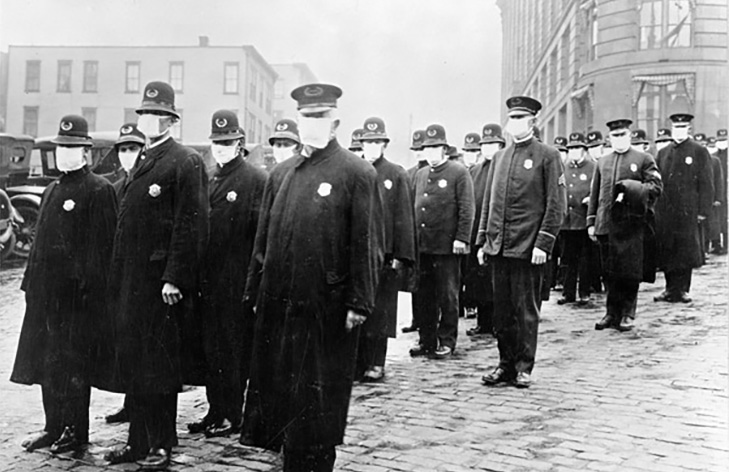To Fight The Flu, Call In The Military

Policemen wearing masks provided by the American Red Cross in Seattle, WA in 1918.
(Inside Science) -- Health workers worried about a possible influenza pandemic have found a source of useful data at the clinics of American military bases.
Researchers investigating the 2009 swine flu epidemic counted when and where military personnel showed up at clinics with flulike symptoms. That data allowed the scientists to build a computer model that should enable them to track the spread of outbreaks.
"The data are very accurate and allows us to test ideas and models. [They] can serve as a sentinel, sort of the canary," said Pete Riley, CFO and senior research scientist at Predictive Science in San Diego, California, and lead author of a paper published last month in PLOS Computational Biology.
Using the military data, which Riley said tends to be more accurate than data from civilian sources, the researchers created incidence profiles at military bases. Because people come and go from military posts, "the way the profiles evolve would be representative of what’s happening in [nearby] cities," said Riley. From those profiles, the scientists estimated the fraction of those infected who actually went to a clinic.
Bases that suffered early infection allowed the model to make predictions about how the outbreak spread across the country. The model could also estimate what percentage of cases would be serious.
The researchers then simulated a future pandemic ten times worse than the one in 2009. They could make predictions about this event even before its peak had passed in the first infected communities.
The model still needs work and is only the latest in the attempts to watch the spread of the disease.
Influenza is not a minor matter. A version in 1918 and 1919, called the Spanish flu, caused a pandemic that killed an estimated 50 million people or more, including 675,000 Americans. That might be as many as were killed by the Black Death in the 14th century. Indeed, the pandemic might rank as the most deadly calamity in human history outside World War II.
It was spread partly by millions of people moving across oceans and continents as World War I ended. Cities all over the world had so many deaths they had to pile bodies in massive trenches to bury them. Oddly, the young and healthy died at the highest rate, in part, it is believed, because older people had gained some immunity from an earlier epidemic. Pregnant women suffered the most.
The pandemic struck in three waves in the U.S. Public places were closed, basic services were interrupted, and people were ordered to wear masks outside.
Epidemiologists fear another flu like that one could strike.
Influenza is extremely contagious. People who come within six feet of a flu sufferer can catch the airborne virus, no cough required. The average flu sufferer infects 1.5-3 people. The disease is a family of virus types with names like H1N1, the cause of the 1918 pandemic. Those viruses are constantly evolving and mutating, churning out new versions, sometimes in a matter of months.
Every year, the World Health Organization guesses which versions of the virus are the most likely to strike that year. That educated guess is turned into a vaccine against the top three or four candidates. The vaccine takes four to six months to produce and usually requires an injection.
In some years, such as 2010, WHO guesses correctly. In some years, such as last year, it is wrong.
An earlier attempt to track the disease was made by Google, which tried to plot the disease by running algorithms of online searches, looking for words such as "flu" or "influenza," as well as references to symptoms. That effort, the Google Flu Trends, made use of huge amounts of data and the law of large numbers, a theorem of probability theory.
In some years, it worked very well, said, Ryan Kennedy, associate professor of political science at the University of Houston. Every other year or so, it bombed, he said. Google has stopped publishing its data.
Part of the problem was that the algorithm used had trouble with search terms. Google researchers had to go into the algorithm and edit them by hand.
Riley said he hopes that his data, plus that from other sources including the Centers for Disease Control and Prevention and GFT, can help scientists prepare for the next big pandemic.

